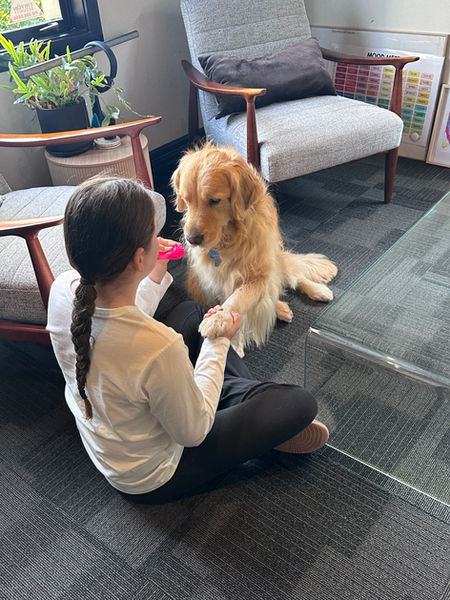
FACILITY DOGS: Louie & Beau
WHAT IS A FACILITY DOG
A facility dog has a specific role and is expertly trained to perform specific tasks as part of this role.
Louie and Beau are specially trained to perform tasks that motivate, inspire and enhance the lives of our clients.
They work alongside their owners/ psychologists to provide animal assisted therapies.
WHAT ARE THE BENEFITS OF A FACILITY DOG?
• Encourages participation in programmes, to achieve treatment goals
• Increases client motivation
• Promotes social interaction and reduces anxiety
• Reduces feelings of loneliness
• Increases feelings of security, belonging, having a purpose
• Improves staff morale
EXAMPLES OF SPECIFIC ACTIVITIES AND OUTCOMES ACHIEVED WITH A FACILITY DOG:
THERAPY TASKS
• Placing the dog’s head on client’s lap or feet – grounding
• Lying beside client
• Engaging with the dog – talking, patting, brushing, connecting
EXAMPLES OF MEASURABLE OUTCOMES:
• Number of participants attending group sessions
• Engagement in individual treatment sessions i.e. showing up!
• Decreased feelings of anxiety, isolation and increased feelings of connection
CRITERIA FOR ENTERING THE TRAINING PROGRAMME FOR A FACILITY DOG: • Obedience trained • Calm temperament • Well mannered • Ability to adapt to new environments and new people • Giver of unconditional love and attention EXPECTATIONS AND RESPONSIBILITY OF THE STAFF MEMBER: The staff member is responsible for meeting the dog’s safety, care, companionship, exercise, health and training requirements. Ongoing evaluation of the dog and handler’s performance will be carried out. It is imperative that the dog’s needs are the highest priority. As a facility dog, the dog will accompany the staff member to work on a daily basis and go home with the staff member each night. This ensures that the dog has a healthy work/life balance and have a loving home environment to rest and recharge in. While working at the facility, the dog must be under the supervision of the staff member or an approved staff member at all times whether inside or outside. The dog must not roam free around the facility and outside areas must be safely fenced or the dog must be on a leash. The dog must have a comfortable quiet space inside the facility to have downtime in its crate or bed. Therapy work can be very draining for the dog, particularly in emotional situations. It’s imperative that the dog’s needs are the highest priority. Training of the dog must be maintained by the staff member. This involves commitment from the staff member to undergo training themselves. Performance of the dog and handler will be regularly reviewed to ensure best practice standards are adhered to and to ensure that the handler has access to the most up to date skills and knowledge. ELIGIBILITY REQUIREMENTS FOR HAVING A FACILITY DOG UNDER PPADT • Must work directly with vulnerable clientele for a minimum of 20 hours a week • Must have the support and approval from their employer for the use of a facility dog • Must be able to utilize the tasks the facility dog is trained to do to encourage and support clients • Must provide a risk management plan for having the facility dog in the work environment • The dog must be an integral part of the work environment or clinical setting and must have been trained especially for this purpose. NB: What a facility dog is not: • A way of taking your dog to work with you. • A way of resolving issues with management about having your dog at work. PPADT will only accept facility dog teams where the dog has been / is being trained to be an integral part of the clinical/work setting. This along with the dog’s foundation skills and specific trained tasks that the dog does to help in their clinical setting will be assessed by PPADT prior to acceptance, and throughout the programme. PPADT will provide oversight and guidance.



